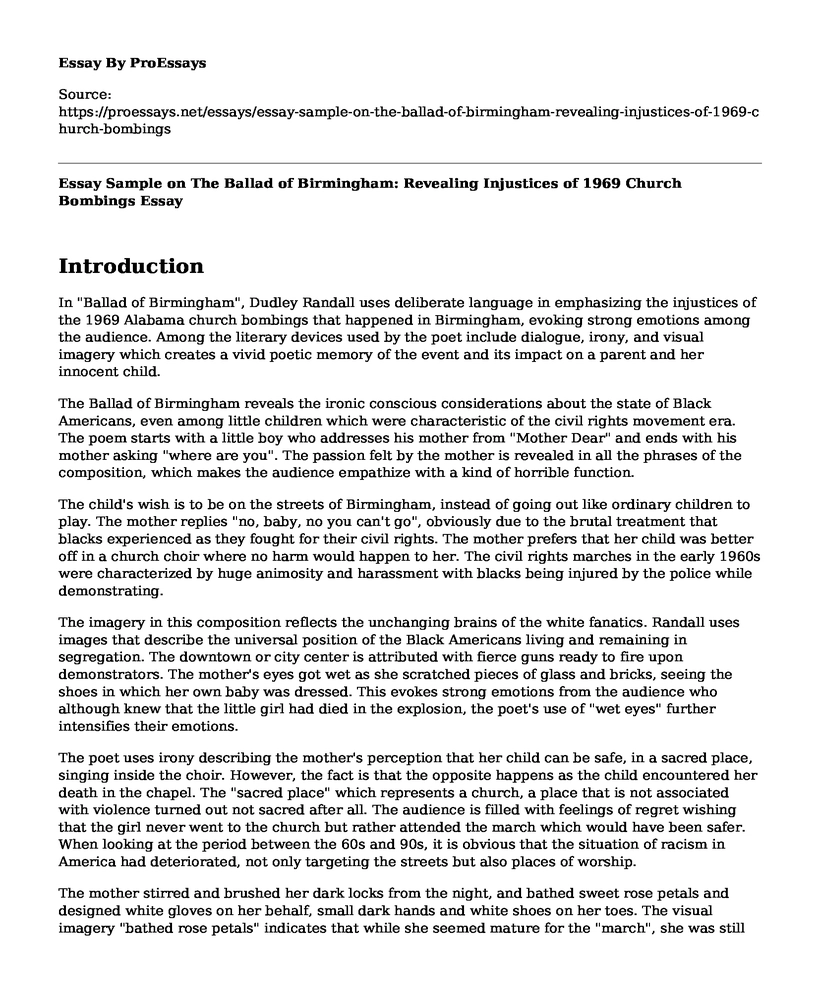Introduction
In "Ballad of Birmingham", Dudley Randall uses deliberate language in emphasizing the injustices of the 1969 Alabama church bombings that happened in Birmingham, evoking strong emotions among the audience. Among the literary devices used by the poet include dialogue, irony, and visual imagery which creates a vivid poetic memory of the event and its impact on a parent and her innocent child.
The Ballad of Birmingham reveals the ironic conscious considerations about the state of Black Americans, even among little children which were characteristic of the civil rights movement era. The poem starts with a little boy who addresses his mother from "Mother Dear" and ends with his mother asking "where are you". The passion felt by the mother is revealed in all the phrases of the composition, which makes the audience empathize with a kind of horrible function.
The child's wish is to be on the streets of Birmingham, instead of going out like ordinary children to play. The mother replies "no, baby, no you can't go", obviously due to the brutal treatment that blacks experienced as they fought for their civil rights. The mother prefers that her child was better off in a church choir where no harm would happen to her. The civil rights marches in the early 1960s were characterized by huge animosity and harassment with blacks being injured by the police while demonstrating.
The imagery in this composition reflects the unchanging brains of the white fanatics. Randall uses images that describe the universal position of the Black Americans living and remaining in segregation. The downtown or city center is attributed with fierce guns ready to fire upon demonstrators. The mother's eyes got wet as she scratched pieces of glass and bricks, seeing the shoes in which her own baby was dressed. This evokes strong emotions from the audience who although knew that the little girl had died in the explosion, the poet's use of "wet eyes" further intensifies their emotions.
The poet uses irony describing the mother's perception that her child can be safe, in a sacred place, singing inside the choir. However, the fact is that the opposite happens as the child encountered her death in the chapel. The "sacred place" which represents a church, a place that is not associated with violence turned out not sacred after all. The audience is filled with feelings of regret wishing that the girl never went to the church but rather attended the march which would have been safer. When looking at the period between the 60s and 90s, it is obvious that the situation of racism in America had deteriorated, not only targeting the streets but also places of worship.
The mother stirred and brushed her dark locks from the night, and bathed sweet rose petals and designed white gloves on her behalf, small dark hands and white shoes on her toes. The visual imagery "bathed rose petals" indicates that while she seemed mature for the "march", she was still an innocent little child. The little girl was happy and the mother smiled, unaware that her end was near. This dialogue is a good example of the interactions between parents and children that will no longer exist in many families as they unexpectedly lose their loved ones amidst societal injustices.
Conclusion
The 1969 church bombings represented a horrific event that aroused sad and bitter emotions. Randall uses such literary tools as irony, visual imagery and dialogue to reconstruct a setting that evokes strong emotions among the readers through the unfortunate lens of a mother losing her child in the fight of racial discrimination in America.
Work Cited
Randall, Dudley. Ballad of Birmingham. Detroit, MI: Broadside Press, 1965.
Cite this page
Essay Sample on The Ballad of Birmingham: Revealing Injustices of 1969 Church Bombings. (2023, May 02). Retrieved from https://proessays.net/essays/essay-sample-on-the-ballad-of-birmingham-revealing-injustices-of-1969-church-bombings
If you are the original author of this essay and no longer wish to have it published on the ProEssays website, please click below to request its removal:
- The Shared Philosophical Perspective of Robinson Jeffers, William Saroyan, and John Steinbeck
- Glenn Altschuler "All Shook Up: How Rock 'n' Roll Changed America" Essay
- Impact of the Great Depression on United States Culture - Essay Sample
- Critical Essays Discussing the Short Story "A Good Man is Hard to Find" by Flannery O'Connor
- Essay Example on Vivid Tones and Sacrifice in Helmet for My Pillow
- Essay on Ronald Reagan's Masterful Communication in the Face of the Challenger Disaster
- Edouard Glissant: A French Writer's Journey in Colonial Reality - Essay Sample







